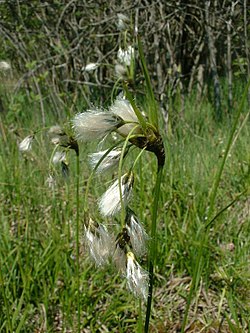Category:Cyperaceae
| Cyperaceae | |
|---|---|

| |
| Cyperus polystachyos flower head | |
| Scientific classification | |
| Kingdom: | Plantae |
| Clade: | Angiosperms |
| Clade: | Monocots |
| Clade: | Commelinids |
| Order: | Poales |
| Family: | Cyperaceae Juss.[1] |
| Genera | |
|
About 109 (not all listed here) | |
The Cyperaceae are a family of monocotyledonous graminoid flowering plants known as sedges, which superficially resemble grasses and rushes. The family is large, with some 5,500 known species described in about 90 genera,[2][3] the largest being the Carex genus of "true sedges"[4][5] with over 2,000 species.[6] These species are widely distributed, with the centers of diversity for the group occurring in tropical Asia and tropical South America. While sedges may be found growing in almost all environments, many are associated with wetlands, or with poor soils. Ecological communities dominated by sedges are known as sedgelands.
Features distinguishing members of the sedge family from grasses or rushes are stems with triangular cross-sections (with occasional exceptions) and leaves that are spirally arranged in three ranks (grasses have alternate leaves forming two ranks).[7][8][9]
Some well-known sedges include the water chestnut (Eleocharis dulcis) and the papyrus sedge (Cyperus papyrus), from which the Ancient Egyptian writing material was made. This family also includes cotton-grass (Eriophorum), spike-rush (Eleocharis), sawgrass (Cladium), nutsedge or nutgrass (Cyperus rotundus, a common lawn weed), and white star sedge (Rhynchospora colorata).
Selected genera

- Abildgaardia
- Actinoscirpus
- Actinoschoenus
- Afrotrilepis
- Alinula
- Amphiscirpus
- Androtrichum
- Arthrostylis
- Ascolepis
- Becquerelia
- Baumea
- Blysmus
- Bolboschoenus
- Bulbostylis
- Carex
- Cladium
- Coleochloa
- Cymophyllus
- Cyperus
- Desmoschoenus
- Dulichium
- Eleocharis
- Eleogiton
- Elyna
- Eriophorum
- Ficinia
- Fimbristylis
- Fuirena
- Gahnia
- Hypolytrum
- Isolepis
- Kobresia
- Kyllinga
- Lagenocarpus
- Lepidosperma
- Lepironia
- Lipocarpha
- Machaerina
- Mapania
- Mariscus
- Mesomelaena
- Morelotia
- Oreobolus
- Oxycaryum
- Pycreus
- Remirea
- Rhynchospora
- Schoenoplectus
- Schoenoplectiella
- Schoenus
- Scirpodendron
- Scirpoides
- Scirpus
- Scleria
- Trichophorum
- Uncinia
- Websteria
References
- ↑ Angiosperm Phylogeny Group (2009). "An update of the Angiosperm Phylogeny Group classification for the orders and families of flowering plants: APG III" (PDF). Botanical Journal of the Linnean Society. 161 (2): 105–121. doi:10.1111/j.1095-8339.2009.00996.x. Retrieved 2013-06-26.
- ↑ Christenhusz, M. J. M.; Byng, J. W. (2016). "The number of known plants species in the world and its annual increase". Phytotaxa. Magnolia Press. 261 (3): 201–217. doi:10.11646/phytotaxa.261.3.1.
- ↑ R. Govaerts; D. A. Simpson; with J. Bruhl; T. Egorova; P. Goetghebeur; K. Wilson (2007). Word Checklist of Cyperaceae: Sedges. Royal Botanic Gardens, Kew. ISBN 978-1-84246-199-0.
- ↑ "Sedge family – definition and more from the free Mirriam-Webster Dictionary". Mirriam-Webster. Retrieved 25 December 2013.
- ↑ Milne, Lorus Johnson; Milne, Margery Joan Greene (1975). Living plants of the world. Random House. p. 301.
- ↑ Hipp, Andrew L. (2007). "Nonuniform processes of chromosome evolution in sedges (Carex: Cyperaceae)" (PDF). Evolution. 61 (9): 2175–2194. doi:10.1111/j.1558-5646.2007.00183.x. ISSN 0014-3820. PMID 17767589.
- ↑ "Grasslike non-grasses". Backyard Nature. Retrieved December 30, 2014.
- ↑ Peter W. Ball; A. A. Reznicek; David F. Murray. "210. Cyperaceae Jussieu". In Flora of North Americaial Committee. Magnoliophyta: Commelinidae (in part): Cyperaceae. Flora of North America. 23. Oxford University Press. ISBN 978-0-19-515207-4.
- ↑ Brian R. Speer (September 29, 1995). "Glumiflorae: More on Morphology". University of California, Berkeley. Retrieved March 23, 2007.
External links
- Cyperaceae at The Plant List
- Cyperaceae at The Families of Flowering Plants (DELTA)
- Cyperaceae at the Encyclopedia of Life
- Cyperaceae at the Angiosperm Phylogeny Website
- Cyperaceae at the Royal Botanic Gardens, Kew
- Cyperaceae at the online Flora of North America
- Cyperaceae at the online Flora of Michigan
- Cyperaceae at the online Flora of Northern Ireland
- Cyperaceae at the online Flora of Zimbabwe
- Cyperaceae at the online Flora of Western Australia
- Cyperaceae at the online Flora of New South Wales
- Cyperaceae at the online Flora of New Zealand
- Cyperaceae at Flowers in Israel
Acknowledgements
This article uses material from the Wikipedia article Cyperaceae, which is released under the Creative Commons Attribution-Share-Alike License 3.0.
Pages in category "Cyperaceae"
The following 5 pages are in this category, out of 5 total.

